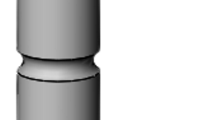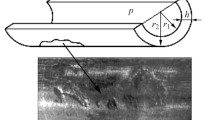We consider a problem of cracking of metals (formation of blisters) in the oil-and-gas equipment. The causes of initiation of the nuclei of hydrogen blisters are investigated and, on this basis, a mathematical model of their growth is developed with regard for the electrolytic hydrogenation of the metal surface, hydrogen diffusion into the metal, and its accumulation in the internal microdefects. We also present an example of analysis of the kinetics of growth of circular blisters in low-carbon and low-alloy steels under the action of hydrogen penetrating into the metal in the process of corrosion in wet hydrogen-sulfide media.
Similar content being viewed by others
References
A. A. Gonik and G. M. Pavlov (editors), Corrosion and Protection in Oil-and-Gas Industry: Corrosion Cracking of the Oil-and-Gas Equipment and Protection Against This Phenomenon [in Russian], VNIIOÉNG, Moscow (1977).
L. S. Saakiyan and A. P. Efremov, Corrosion Protection of the Oil-and-Gas Field Equipment [in Russian], Nedra, Moscow (1982).
A. S. Grintsov, “A possible scheme of the formation of pyrophoric deposits in the gas-processing equipment,” in: Corrosion and Protection of the Environment [in Russian], Issue 10 (1984), pp. 4–6.
É. M. Gutman, Corrosion Protection of the Oil Field Equipment [in Russian], Nedra, Moscow (1983).
A. P. Lubenskii and Z. P. Semikolenova, “Effect of temperature on the corrosion of pipe steel in water–hydrogen-sulfide solutions,” in: Corrosion and Protection of the Environment [in Russian], Issue 11 (1984), pp. 1–5.
V. V. Egorov and V. V. Batrakov, “Influence of hydrogen sulfide on the rate of dissolution of iron in sodium-sulfate solutions under the conditions of natural aeration,” in: Contemporary Methods for the Investigation and Prevention of Corrosion Fracture [in Russian], Izhevsk (2001), pp. 138–139.
V. A. Marichev, “Hydrogen embrittlement in the problem of corrosion cracking of structural metals and alloys,” Zashch. Met., 15, No. 15, 533–544 (1979).
A. V. Shreider, I. S. Shparber, and Yu. I. Archakov, Influence of Hydrogen on the Chemical and Oil-Processing Equipment [in Russian], Mashinostroenie, Moscow (1976).
A. A. Gonik, Corrosion of the Oil Field Equipment and Measures for Its Prevention [in Russian], Nedra, Moscow (1976).
Yu. I. Rubenchik, T. A. Pisarenko, and G. Yu. Dokukina, “Influence of structural parameters on the hydrogen embrittlement and cracking of low-alloy welded steels,” in: Serviceability of Structural Metallic Materials in Hydrogen [in Russian], Preprint No. 33, Karpenko Physicomechanical Institute, Ukrainian National Academy of Sciences, Lviv (1980).
S. A. Golovanenko, G. G. Irzhov, and T. K. Sergeeva, “The role of manganese sulfides in the hydrogen embrittlement of steels for gas mains,” in: Hydrogen Permeability and Saturation of Steel with Hydrogen [in Russian], Preprint No. 34, Karpenko Physicomechanical Institute, Ukrainian National Academy of Sciences, Lviv (1980).
E. É. Glikman, E. V. Mindukshev, V. P. Morozov, and É. K. Zenkova, “Kinetics of microcracks in the process of hydrogenation of α-iron with admixtures of phosphorus, sulfur, and carbon,” Fiz.-Khim. Mekh. Mater., 20, No. 3, 32–39 (1984).
E. É. Glikman, E. V. Mindukshev, and V. P. Morozov, “Initiation of microcracks in the process of hydrogenation of α-Fe with admixtures of phosphorus, sulfur, and carbon,” Fiz. Met. Metalloved., 59, No. 5, 1018–1026 (1985).
A. B. Vainman, R. K. Melekhov, and O. D. Smiyan, Hydrogen Embrittlement of the Elements of High-Pressure Boilers [in Russian], Naukova Dumka, Kiev (1990).
V. I. Yavoiskii, S. A. Bliznyukov, A. F. Vishkarev, et al., Inclusions and Gases in Metals [in Russian], Metallurgiya, Moscow (1979).
I. I. Vasilenko and R. K. Melekhov, Corrosion Cracking of Steel [in Russian], Naukova Dumka, Kiev (1977).
O. V. Hembara, Z. O. Terlets’ka, and O. Ya. Chepil’, “Hydrogen concentration near the tip of a corrosion crack,” Fiz.-Khim. Mekh. Mater., 44, No. 1, 109–111 (2008); English translation: Mater. Sci., 44, No. 1, 133–137 (2008).
O. Radkevych, H. Chumalo, I. Domenyuk, and R. Yurkevych, “Basic regularities of hydrogenation and surface blistering for pipe steels in hydrogen-sulfide media,” Fiz.-Khim. Mekh. Mater., Special issue No. 4, 446–449 (2004).
H. S. Carslaw and J. C. Jaeger, Conduction of Heat in Solids, 2nd edition, Clarendon, Oxford (1959).
O. E. Andreikiv and O. V. Hembara, Fracture Mechanics and Durability of Metallic Materials in Hydrogen-Containing Media [in Ukrainian], Naukova Dumka, Kyiv (2008).
A. E. Andreikiv and A. I. Darchuk, “A method for the integral evaluation of the durability of a structural element containing a crack propagating in a plane,” Fiz.-Khim. Mekh. Mater., 24, No. 6, 52–56 (1988).
Author information
Authors and Affiliations
Corresponding author
Additional information
Translated from Fizyko-Khimichna Mekhanika Materialiv, Vol. 45, No. 5, pp. 17–25, September–October, 2009.
Rights and permissions
About this article
Cite this article
Banakhevych, Y.V., Hembara, O.V. & Andreikiv, O.E. Numerical analysis of the kinetics of propagation of hydrogen blisters in the oil-and-gas equipment. Mater Sci 45, 626–637 (2009). https://doi.org/10.1007/s11003-010-9224-1
Received:
Published:
Issue Date:
DOI: https://doi.org/10.1007/s11003-010-9224-1




